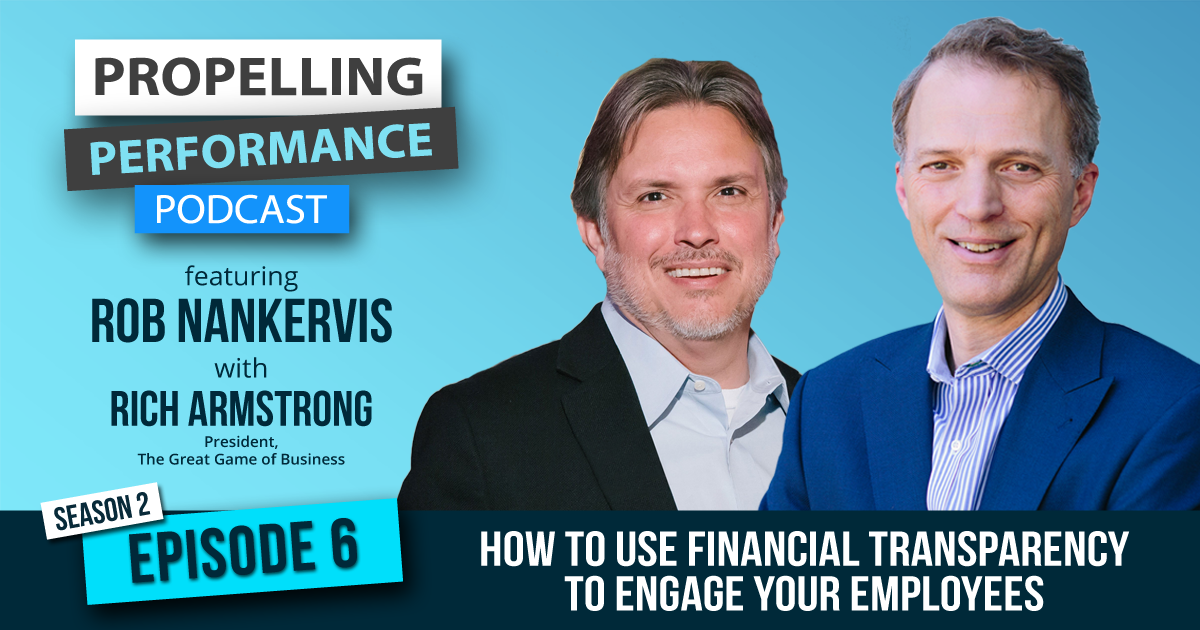Propelling Performance Podcast
SEASON TWO, EPISODE SIX
featuring Rob Nankervis with Rich Armstrong
In Episode Six of the Propelling Performance Podcast, Rob speaks with Rich Armstrong, President, The Great Game of Business. Rich shares strategies to introduce financial literacy into your business; explains principles including financial huddles, scoreboard and mini games; discusses common mistakes he sees from leaders; how to build engagement in your organisation and examples of how to get started by creating and using a mini-game.
“We’re very big believers that the most efficient, most profitable way to operate a business is just to teach everyone in the organisation how the business makes money, give them a voice in how the company is run, and then provide a stake in the outcome if we’re all successful.” – Rich Armstrong
Listen to discover:
The origins of the idea for the Great Game of Business, and ownership by SRC Holdings Corporation
Insights into how Jack Stack used financial literacy to bring people together and increase their personal investment in his business
How financial literacy and connection at SRC began to spawn other new businesses.
“When Jack decentralised, we could open up, spin off and acquire smaller businesses.”
Rich’s hallmarks of effective businesses:
- teach everyone in the organisation how the business makes money
- give them a voice in how the company is run
- provide a stake in the outcome if we’re all successful
- Bring these principles alive through high involvement, planning, financial huddles, scoreboard, mini games.
“Use the central ideas of educating your people in the business and empowering them to drive performance. Give them the opportunity to understand how they can make a difference in the organisation.” – Rich Armstrong
Make the numbers visible everywhere. Make a connection to the everyday metrics, how they connect and drive the overall financial picture.
Introduce financial literacy training for everyone, from the CFO or cleaner to the production line, everyone is taught how the financial game is played.
The definition of a ‘mini game’ and how to use it, including reward or recognition when you drive profit or move the needle, such as cash bonuses
Use ‘line of sight’ – make sure employees can see a clear line of sight from what they do every day to impact the business
How to introduce financial transparency to your business
- Combat the fear of being transparent with your employees
- Get comfortable with the ‘risk’ of sharing with your employees
- Adopt the practices – weekly huddles, financial literacy training.
The common mistakes…
- Lack of vulnerability in leadership
- Not having the courage to be transparent
- Being unable to release ‘total control’
- Not looking at this as an operating system, where everything works together
The difference with a financial literacy approach in family owned business vs corporate structures.
“Your employees can step out of that day to day grind and every day whirlwind of activities, and think about how they can grow the business rather than just be in the middle of it.” – Rich Armstrong
How to start building engagement
- Involve your people in the business more than you do today
- Teach them the business, empower them to use that knowledge to help the business be successful
- Help them understand how the business works, understand your customer, the strategy of the business, and your competitive advantage
- Build culture and relationships, and make work meaningful to drive retention and attraction.
Understand how to launch your plan by creating and using a mini-game that is cross-functional and avoid silos. The bottom line is you want people to work together.
Take action!
- With talent shortages a reality, how are you going to become an employer of choice?
- What operating system would you use to do that?
- How will you provide meaningful work for your employees?

Rich Armstrong
President, The Great Game of Business
Rob Nankervis – Podcast guests – Season 2
Rich Armstrong is President, The Great Game of Business and Senior Executive, SRC Holdings Corporation. He has 30 years’ experience improving business performance and employee engagement through open-book management and employee ownership. SRC Holdings Corporation is one of the United States’ top 100 largest majority employee-owned companies and Rich has been instrumental in ongoing development of SRC Holdings’ open-book management and employee-ownership practices through practical, first-hand experience leading several business units. As a business coach he has successfully implemented these practices in small and large-scale global companies. Rich co-authored Get in the Game as well as the update of the number one bestseller, The Great Game of Business – 20th Anniversary Edition.

